Related Research Articles
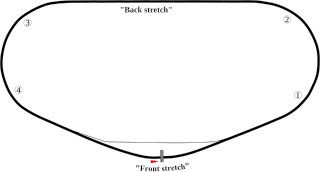
Daytona International Speedway is a race track in Daytona Beach, Florida, United States. Since opening in 1959, it has been the home of the Daytona 500, the most prestigious race in NASCAR as well as its season opening event. In addition to NASCAR, the track also hosts races of ARCA, AMA Superbike, IMSA, SCCA, and Motocross. The track features multiple layouts including the primary 2.500 mi (4.023 km) high-speed tri-oval, a 3.560 mi (5.729 km) sports car course, a 2.950 mi (4.748 km) motorcycle course, and a 1,320 ft (400 m) karting and motorcycle flat-track. The track's 180-acre (73 ha) infield includes the 29-acre (12 ha) Lake Lloyd, which has hosted powerboat racing. The speedway is operated by NASCAR pursuant to a lease with the City of Daytona Beach on the property that runs until 2054. Dale Earnhardt is Daytona International Speedway's all-time winningest driver, with a total of 34 career victories.

The Porsche 935 was a race car developed and manufactured by German automaker Porsche. Introduced in 1976 as the factory racing version of the 911 (930) Turbo and prepared for FIA-Group 5 rules, it was an evolution of the Carrera RSR 2.1 turbo prototype, the second place overall finisher in the 1974 24 Hours of Le Mans.

The BMW M1 is a mid-engined sports car produced by German automotive manufacturer BMW from 1978 until 1981.
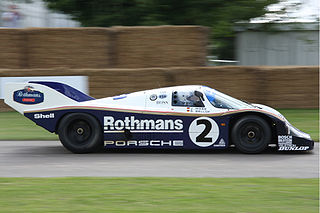
The Porsche 956 was a Group C sports-prototype racing car designed by Norbert Singer and built by Porsche in 1982 for the FIA World Sportscar Championship. It was later upgraded to the 956B in 1984. In 1983, driven by Stefan Bellof, this car established a record that would stand for 35 years, lapping the famed 20.832 km (12.93 mi) Nürburgring Nordschleife in 6:11.13 during qualifying for the 1000 km Sports Car race. The record was finally surpassed by Timo Bernhard in a derestricted Porsche 919 Evo on 29 June 2018.

The Chevrolet Corvette (C4) is the fourth generation of the Corvette sports car, produced by American automobile manufacturer Chevrolet from 1983 until 1996. The convertible returned, as did higher performance engines, exemplified by the 375 hp (280 kW) LT5 found in the ZR-1. In early March 1990, the ZR-1 would set a new record for the highest 24 hour-5,000 mile land-speed by going over a speed of 175 mph (282 km/h). With a completely new chassis, modern sleeker styling, and other improvements to the model, prices rose and sales declined. The last C4 was produced on June 20, 1996.
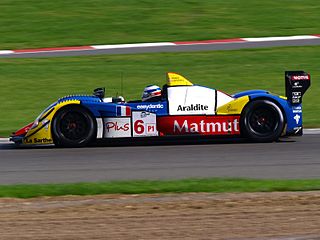
Courage Compétition was a racing team and chassis constructor company now owned by Oreca, based in Le Mans, France near the Circuit de la Sarthe. It was founded by Yves Courage, a French race driver who ran hillclimbs before founding the company. Following the purchase of Courage by Oreca in 2007, Yves Courage has refounded the company as Courage Technology in 2010, attempting to develop electric racing cars.

The Lancia LC2 was a series of racing cars built by Italian automobile manufacturer Lancia and powered by engines built by their sister company Ferrari. They were part of Lancia's official factory-backed effort in the World Sportscar Championship from 1983 to 1986, although they continued to be used by privateer teams until 1991. They were also the company's first car meeting the FIA's new Group C regulations for sports prototypes.
The Lola T610 was a ground effect Group C sports prototype race car, designed, developed and built by British manufacturer Lola, for sports car racing, specifically the IMSA GTP Championship, World Sportscar Championship and 24 Hours of Le Mans, between 1982 and 1984. A total of two models were produced.
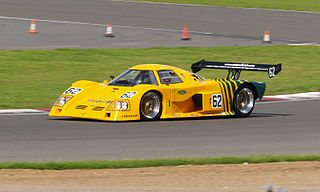
The Ford C100 is a sports racing car, initially built and run as a Group 6 car, but later as a Group C car. The C100 was built by Ford in 1981, and initially featured a 4-litre Cosworth DFL V8 engine, which was replaced by a 3.3-litre version of the same engine in 1983, after the car had passed to private hands. Five cars are known to have been built. Although the cars were often very quick in qualifying, reliability problems plagued them, and restricted their successes to two Deutsche Rennsport Meisterschaft victories in 1982, and a single Thundersports victory in 1983.
The Cougar C01, and its deriative, the Cougar C01B, were Group C sports car prototype race cars, designed, developed, and built by French constructor Cougar in 1984, and was used in sports car racing from 1982 to 1984. Its best result in the World Sportscar Championship sports car racing series was a tenth-place finish 1983 1000 km of Mugello, being driven by Yves Courage, Aldo Bertuzzi, and Gianni Giudici.

The Courage C30, also known as the Courage C30LM, was a Group C2 sports prototype, designed, developed and built by French manufacturer Courage in 1993. It famously contested in the 1993 24 Hours of Le Mans, with drivers Derek Bell and Pierre Yver finishing in 10th and 11th place, respectively.

The Courage C34 was a sports car prototype, designed, developed and built by French manufacturer Courage in 1995. It famously contested the 1995 24 Hours of Le Mans, where it managed to finish 2nd overall in its class.
The Cougar C20 was a Group C sports car prototype used in sports car racing from 1987 to 1990.
The Cougar C22 was a Group C sports car prototype used in the World Sports-Prototype Championship sports car racing series, from 1988 to 1989.

The Cougar C26S was a Group C sports car prototype built by Courage Compétition. It was used in the World Sports-Prototype Championship sports car racing series in 1991. Power came from a 3.0-liter Porsche 6-cylinder turbocharged engine. It achieved one podium finish; with its best results being a 2nd-place finish at the 1991 Most Interserie race, being driven by Frenchman Lionel Robert.

The Cougar C28 was a Group C sports car prototype build by Courage. It was used in the World Sports-Prototype Championship sports car racing series in 1992. Power came from a 3.0-liter Porsche 6-cylinder turbocharged engine. It managed to achieve an impressive 3 podium finishes and 1 class win. Highlights include an overall 6th-place finish at that year's prestigious 24 Hours of Le Mans, two third-place finishes and a sixth-place finish for Tomas Saldaña at the Interserie races in Jarama, Zeltweg, and Brands Hatch (respectively), and a third-place finish for Marco Brand at the Interserie race in Mugello.
The Cougar C12 was a Group C sports car prototype race car, designed, developed and built by French constructor Cougar in 1985, and used in sports car racing from 1985 to 1988. Its best result was an 18th-place finish at the 1986 24 Hours of Le Mans, being driven by Yves Courage, Alain de Cadenet, and Pierre-Henri Raphanel.
The Alba AR6 was a Group C2 sports car prototype, designed, developed and built by Italian manufacturer Alba Engineering in 1985, to compete in the World Sportscar Championship, and used in sports car racing until 1990. A variant of the car, called the Alba AR8, was used in the IMSA GTP Championship.
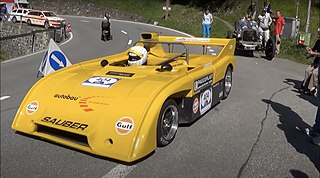
The Sauber C3 was the third sports prototype racing car that Swiss Peter Sauber designed and developed. It was built in 1973. It scored one race win, seven podium finishes, clinched one pole position, and achieved three additional wins in its class. It was powered by a naturally aspirated 2.0 L (120 cu in) Ford-Cosworth BDG four-cylinder engine, developing 280 hp (210 kW).
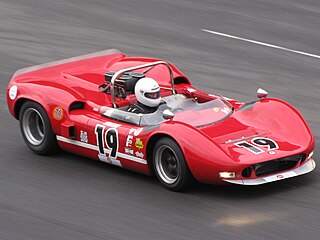
The McLaren M1A, and its derivatives, the McLaren M1B and the McLaren M1C, are a series of mid-engined Group 7 sports prototype race cars built by McLaren, between 1963 and 1968. The M1A was the team's first self-designed and developed sports car. Later versions, such as the 'M1B' and 'M1C', competed and raced in the North American Can-Am series, starting in 1966 season. The car was raced in North America and Europe in 1963 and 1964 in various Group 7 and United States Road Racing Championship series events. 24 examples of the M1A and M1B were built, and 25 examples of the M1C were manufactured. They were powered by a few different motors, including Chevrolet small-block engine, an Oldsmobile V8 engine, a Chevrolet big-block engine, and even a Ford FE engine. It was constructed out of a tubular space frame chassis, and, combined with its light weight of 551 kg (1,215 lb) this gave it a great power-to-weight ratio. The 4.5 L (270 cu in) Oldsmobile V8 engine developed around 310 hp (230 kW), while the 350 cu in (5.7 L) Chevrolet small-block V8 engine was capable of developing over 550 hp (410 kW), and 538 lb⋅ft (729 N⋅m) of torque. This drove the rear wheels through a Hewland L.G.500 four-speed manual transmission.
References
- ↑ "Cougar C02". Archived from the original on 18 June 2022. Retrieved 17 June 2022.
- ↑ "Cougar C02 results". Archived from the original on 18 June 2022. Retrieved 17 June 2022.
- ↑ "Courage Cougar C02, 1983 [Auta5P ID:3464 EN]". auta5p.eu. Archived from the original on 2020-12-30. Retrieved 2022-06-17.